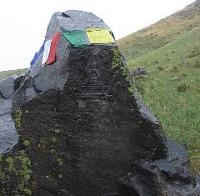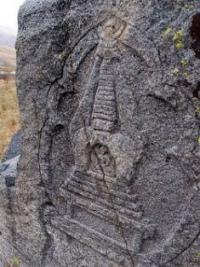You are here
Buddhist inscriptions of Taigak gorge.


Travels to Petroglyph in Kazahtsan.
“From mani padme hum”
A trip to the Taigak gorge of the Altyn-Emel National Park.
In Taigak Gorge, Buddhist prayer inscriptions in the Tibetan language were discovered and explored. In total, 27 Buddhist inscriptions are known in the gorge. Most of them are carved on the steep cliffs of the canyon of the main gorge, on the right bank of the stream.
The inscriptions are embossed both on large flat surfaces and in shallow niches. Moreover, all the inscriptions are located at the bottom of the rocky exits and blocks, to which there is an opportunity to come close or ride a horse.
These inscriptions are made in Tibetan, like most Buddhist inscriptions known in Kazakhstan. Most of the inscriptions studied contain the same universal protective and magical prayer formula as follows: Om mani padme hum. N.N. Pantusov translated this prayer formula as: “O treasures of the lotus! Amen".
It seems to us more fully reflecting the meaning of this prayer formula by Yu.N. Roerich: "May the lotus flower be blessed." In order to understand the meaning of these inscriptions, it is necessary to consider the semantics of the lotus flower in the Buddhist tradition.
The lotus flower symbolizes the whole world, the teachings of Buddhism, Shakya Muni himself, purity rising from the bustle and material bonds of our world, and finally, in some cases, heavenly fire. Then the meaning of the appeal to the lotus flower becomes clear - this is an appeal to all the forces of light, truth, goodness.
Man, pronouncing or reading these inscriptions, according to the ideas of Buddhists, had the opportunity to join the highest purity of the Buddha, get support in his desire to improve and find ways and protection from the forces of evil and his own desires.
Therefore, it is no coincidence that one magic prayer formula is repeated many times: a person sought to apply this formula as many times as possible in order to protect himself and improve his karma through rejection of desires.
There is no consensus among researchers regarding the time these inscriptions were created. A. S. Amanzholov dates these inscriptions in the Tibetan language by the middle of the VIII century. A number of other researchers connect the appearance of Buddhist inscriptions in the Taigak gorge with the period of the Kazakh-Dzungarian wars (XVII - XVIII centuries).
A comparison of the Taigak inscriptions with others known in Semirechye and Kyrgyzstan allows, in our opinion, to attribute them in style and iconography to the earlier stages of the penetration of Buddhism in emirechye.
Probably the whole complex was created in the IXth - X0th centuries as a result of Tibetan influence. Later Jungar Buddhist complexes differ significantly not only in the style of inscriptions, but also in structure. The Taigak complex is located linearly, stretched along the stream, while all the Dzungar ones have the structure of a Buddhist temple and are closed, limiting a certain specially organized space.
The inscriptions known in Kyrgyzstan south of the Tamga gorge and in the Tamgaly-Tas tract on the Ili River have exactly this structure.
Authority:
The book "Rock paintings of the Seven Rivers", authors: Maryashev AN, Goryachv A.A. second edition revised and expanded, Almaty, 2002.
Photos by
Alexander Petrov.







